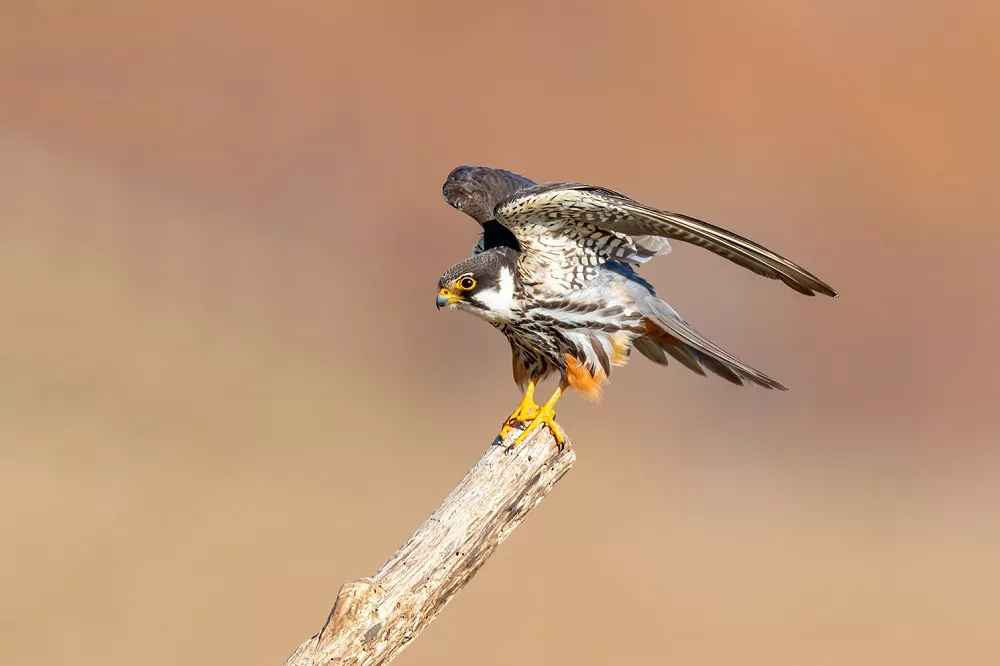The Eurasian hobby (Falco subbuteo) or just hobby, is a bird of the Falco family and the genus Falco. The body is about 36 cm long and weighs 140-340 grams. Smaller than the Saker falcon, Peregrine falcon, etc., it is a small raptor with dark blue-brown upper body and white lower body with dark stripes. Leg feathers light red. Most individuals are migratory. It mainly feeds on passerine birds such as sparrows and tits, and also eats insects. Breeding in Europe, Northwest Africa, Russia, etc., overwintering in Japan, India, Laos, Myanmar and other places.
What does Eurasian hobby look like
The Eurasian hobby has a body length of about 36 cm, a wingspan of 68-84 cm, and a weight of 140-340 grams. Smaller than Saker Falcon, Peregrine Falcon, etc., it is a small raptor. The beak is shorter than that of hawks, with tooth processes on both sides of the apex, and the base is not covered with cereus or whisker feathers; the nostrils are round, and a columnar bony stick can be seen inward from the nostrils; the wings are long and narrow, and the flapping rhythm is fast ; The tail is slender. The wings are narrow and pointed.
The upper body of the male bird is red brick, with black triangular spots on the back and wings; the top of the head, the back of the neck, and the side of the neck are blue-gray. The flight feathers are nearly black, with off-white feather ends; the tail feathers are blue-gray, with broad black sub-terminal spots, and the feather ends are off-white. The lower body is milky yellow with light brown, with dark brown feathers and rough spots. Mouth base blue-yellow, tip gray. Feet dark yellow.
The upper body of the female bird is dark brown, mixed with dark brown horizontal spots; the top of the head and the back of the neck are light brown, with dark brown feathers; the tail feathers are dark brown, with 9-12 dark brown horizontal spots.
Juvenile birds are similar to female birds, but with heavier longitudinal stripes. The difference from the yellow-clawed falcon is that the tail is round, the body is larger, and it has mustache lines. The male bird has spots on the back, more vertical lines on the lower body, and lighter cheeks.
Easy identification: there are eye spots under the eyes, and dark spots on the back. There are dark spots on the chest. Hover while flying. Female birds are larger than males. Some males and females are the same length. The body is slender. Mouth claws smaller than females.
When the wings are folded, the tips of the wings almost reach the end of the tail feathers, which looks a lot like a swallow, hence the name. The iris is dark brown, the eye area and cere are yellow, the mouth is blue-gray, the tip is black, the feet and toes are yellow, and the claws are black.
Eurasian Hobby Habitat and Range
Eurasian Hobbies inhabit a variety of environments, including open woodlands, heathlands, and farmlands with stands of trees. They often hunt over nearby water bodies and marshes. During migration and wintering periods, they prefer open landscapes and avoid dense forests. Their breeding range extends across Europe and temperate regions of Asia. In winter, they migrate to Africa south of the Sahara Desert, covering distances of 10,000 km or more between their breeding and wintering grounds.
Eurasian Hobby Hunting Techniques
The Eurasian Hobby is a master of speed and agility, using its curved wings to perform sharp turns while chasing prey. It primarily hunts at dusk when insects like dragonflies and beetles are active, and it also preys on smaller birds, catching them in mid-air with impressive precision. The Eurasian Hobby is known for its fast flight speed, which can reach up to 100 km/h (62 mph) in level flight. However, it is also capable of much faster speeds when diving or stooping to catch prey. During a stoop, the Eurasian Hobby can reach speeds of up to 160 km/h (99 mph) or more. This makes it one of the fastest birds in the world.
Eurasian Hobby Diet
The Eurasian Hobby’s diet consists mainly of small birds and flying insects. It feeds on birds such as larks, martins, swifts, finches, and sparrows. Insects like dragonflies, moths, and locusts are also common prey. Occasionally, it may catch bats or small mammals. The hobby’s sharp beak and talons are crucial for its hunting prowess.
Breeding and Nesting
Eurasian Hobbies do not build their own nests; instead, they use old nests built by other birds, such as crows or ravens, located high in trees. During the breeding season, which starts in May, the female lays three to four eggs. Both parents take turns incubating the eggs for about four weeks. Once the chicks hatch, both parents work together to feed and protect them until they fledge after about five weeks.
Migration Patterns
Eurasian Hobbies are migratory birds, with their breeding range covering a vast area from Europe to Asia. They migrate to Africa for the winter, traveling long distances. For example, some Eurasian Hobbies migrate from Sweden to Angola and Zambia, covering an average distance of about 9,200 kilometers.
Lifespan and Population
In the wild, Eurasian Hobbies typically live between 10 to 14 years. They occur in small numbers and low population densities across their vast range. The oldest recorded Eurasian Hobby was about 15 years old.
Conservation Status
According to the International Union for Conservation of Nature (IUCN), the Eurasian Hobby is currently classified as Least Concern (LC). The total population is estimated to be between 900,000 to 1,500,000 mature individuals.
Conclusion
The Eurasian Hobby is an extraordinary bird of prey, known for its agility, speed, and remarkable hunting skills. Its adaptability to various habitats and its role in maintaining ecological balance make it a fascinating species to study and observe. As we continue to learn more about this bird, it is crucial to ensure the preservation of its natural habitats to safeguard its future.


 Facebook
Facebook  Instagram
Instagram  Youtube
Youtube 